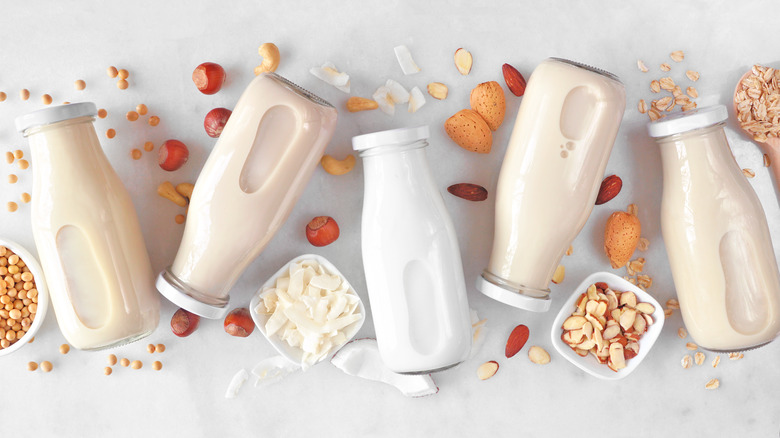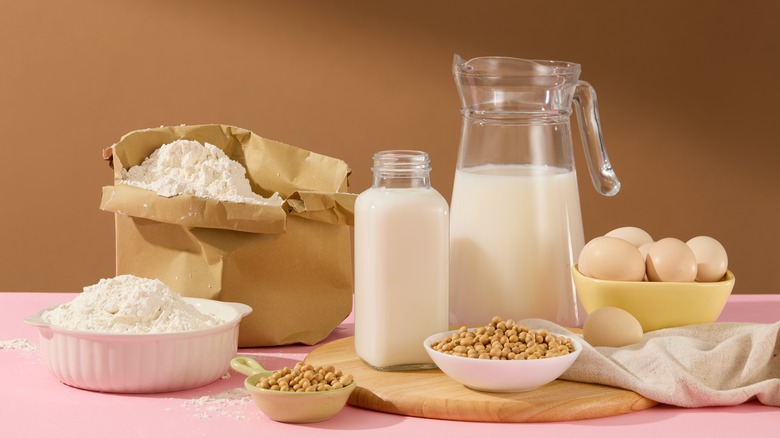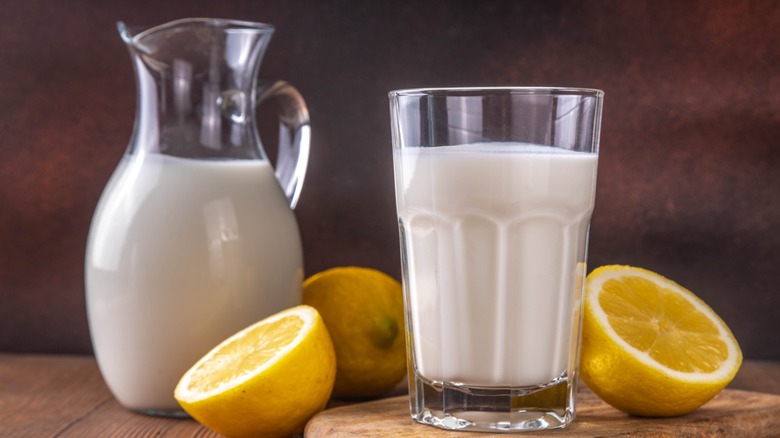The One Non-Dairy Milk You Should Avoid When It Comes To Baking
Most dishes taste better with a little butter and cream, especially in baking where they act as essential ingredients that can truly make or break a recipe. Like everything related to baking, though, it's all a precise science. And if you're thinking of making a dairy swap, some milk products are better than others as the choice can affect the crumb, mouthfeel, and taste.
If you're lactose-intolerant or want to make dairy-free baked goods, all hope it not lost for a substitution. There are a lot of good plant-based choices for baking, and many can be substituted 1:1 for cow's milk. But you may want to steer clear of one: rice milk.
Made from blending rice and water, rice milk is a delicious beverage and a safe alternative for individuals with an array of food allergies. However, when used in baking, it can deliver inconsistent results. Its low fat and protein content and thin consistency impact a recipe's structure and ability to brown. Baked goods won't rise to their full potential and have a drier texture.
If you prefer rice milk, reserve it for recipes containing eggs, which provide the fat and protein rice milk lacks. For egg-free recipes, you'll need to add a thickening agent or stabilizer to compensate for its water-like consistency. Start with a teaspoon of xanthan gum, flour, or cornstarch for every cup of rice milk, and adjust the ratio as needed. Though, if you can tolerate other non-dairy milk alternatives, there are more reliable options.
The best non-dairy milk for baking
Unless specified, it's safe to assume that baking recipes are written with whole milk in mind. So, to bake plant-based baked goods with consistent results, you'll want an alternative that's the most similar, which is soy milk. Cow's milk contains 8 grams of protein per serving. Compared to other options like cashew, almond, and oat milk, soy has the highest protein content, with 7 grams per serving, enabling cake layers to brown nicely and creating tender and moist bread.
As a general rule of thumb, you should enjoy the taste of non-dairy alternatives before using them in recipes, like when cooking with wine. Soy milk's neutral flavor means that you shouldn't detect the swap in recipes. However, if you're sensitive to the taste, vanilla-flavored options are readily available and may complement some desserts.
Remember to read the nutritional panel before purchasing since its sugar content is also a factor in how it tastes. Although unflavored cow's milk doesn't contain added sugar, it still has 12 grams of natural sugar (AKA lactose) per serving, which adds sweetness to recipes. Unsweetened soy contains 1 gram of sugar, so if you want the same sweetness, you can add more sugar to the recipe or look for lightly sweetened soy milk options. But be mindful that some brands can have as much as 20 grams of sugar per serving.
Tips for baking with non-dairy milk
When baking with non-dairy milk alternatives, there are a few additional things to keep in mind. One example is scalded milk. While it's not required in all recipes, scalded milk is sometimes called for when making yeast-based bread. This technique involves simmering milk until it reaches 180 degrees Fahrenheit before adding it to the recipe. Cow's milk boils at 212 degrees Fahrenheit, so scalded milk isn't meant to boil, but let's be honest, it sometimes does.
When substituting some plant-based milks, boiling can cause them to separate. If this happens, allow the non-dairy liquid to cool to 110 degrees Fahrenheit and then stir the liquid to see if it emulsifies. If that doesn't work, add a thickening agent and stir until it has a uniform consistency. (This is a good tip for using plant-based milk in lattes, too.)
Also, if possible, use full-fat products for the best-tasting results. So, when a recipe calls for buttermilk, create an easy non-dairy version by adding a teaspoon of lemon juice or vinegar (white or apple cider) to ⅓ cup of plant-based milk. Compared to regular dairy, it will be thinner and take longer to curdle, but it will still provide the tanginess required. Keep in mind, when using a higher water content alternative, like rice milk, you may need additional acid for the reaction to take place.



